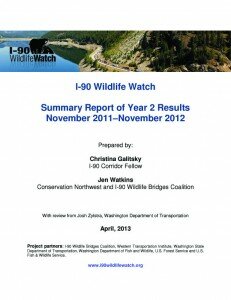Second annual report released
As we enter our third year of I-90 Wildlife Watch, we have summarized the results of our project’s second full year from  November 2011 through November 2012 into an annual report. In our second year, over 2,000 visitors reported 282 valid (i.e. presumed authentic) wildlife sightings made in the survey area, comprising a total of 241 live and 41 dead animals.
November 2011 through November 2012 into an annual report. In our second year, over 2,000 visitors reported 282 valid (i.e. presumed authentic) wildlife sightings made in the survey area, comprising a total of 241 live and 41 dead animals.
“We are thrilled that a full year after our project’s launch there continues to be interest from motorists in reporting what they see from their cars as they drive I-90 in the project area,” said Jen Watkins, project coordinator with I-90 Wildlife Bridges Coalition. “The people submitting reports on our site are not only contributing to biologists and planners knowledge of wildlife presence in this important landscape, but providing a human perspective on their experience through their comments.”
Reports represented 15 mammal species, including deer, elk, black bears, cougars, coyotes, foxes, otters, mice, hare, raccoons, skunks, woodrats and one cow, as well as several bird species. In one report from 2012, the motorist reported that the animal “Was in the roadway, I put my flashers on to alert the driver behind me. The coyote moved safely into the median.”
During our second year several events stood out, catching not only motorists’ attention but our own. During last year’s Memorial Day weekend, a black bear attempting to cross the busy highway near Hyak on Sunday morning didn’t make it: the 250-pound male was killed by a vehicle in the eastbound lanes after reportedly navigating westbound traffic. The vehicle immediately drove away, and the bear’s carcass was collected by the Washington Department of Fish and Wildlife – which reported it would use the hide for classroom education.
Then, in August 2012, several people informed us that a cougar was struck by a vehicle on I-90 east of North Bend during the evening. This upsetting incident was apparently witnessed by many motorists, some of whom reportedly slowed or stopped their vehicles to investigate the scene and protect the animal from further trauma. The cougar, which was bleeding from the head, sat dazed in the roadway and was apparently fatally injured. Coincidentally, the collision occurred within a mile or two of a live cougar crossing reported to I-90 Wildlife Watch in July.
Our second year produced more live wildlife sightings along Interstate 90 than dead reports, but the unsuccessful crossing of animals over Interstate 90 is a reminder of the safety risks posed to both wildlife and motorists when roadways cut through wildlife habitats. Within the I-90 Wildlife Watch project area, the Washington State Department of Transportation is working to create safer passage for people and wildlife through the I-90 Snoqualmie Pass East Project. Beyond providing data and a narrative to wildlife approaching and attempting to cross Interstate 90, the motorists reporting wildlife sightings are directly informing department as they construct and monitor this project.
“I-90 Wildlife Watch helps the Washington State Department of Transportation by tapping into several thousand sets of eyes as commuters traverse Snoqualmie Pass,” stated Craig Broadhead, South Central Region WSDOT biologist. “This citizen science effort provides invaluable information to help us tailor objectives and ultimately define success regarding the restoration of ecological connectivity on the I-90 Project.”
Results from the project’s second year are provided in a report on our Maps and Results page, as are acknowledgements to the many individuals and organizations that have made this project possible and a description of changes that are underway to the project in our third year.
Direct link to our Year 2 Annual Report: https://i90wildlifewatch.org/wp-content/uploads/2013/04/2011-12_I90WildlifeWatchAnnualReport.pdf





